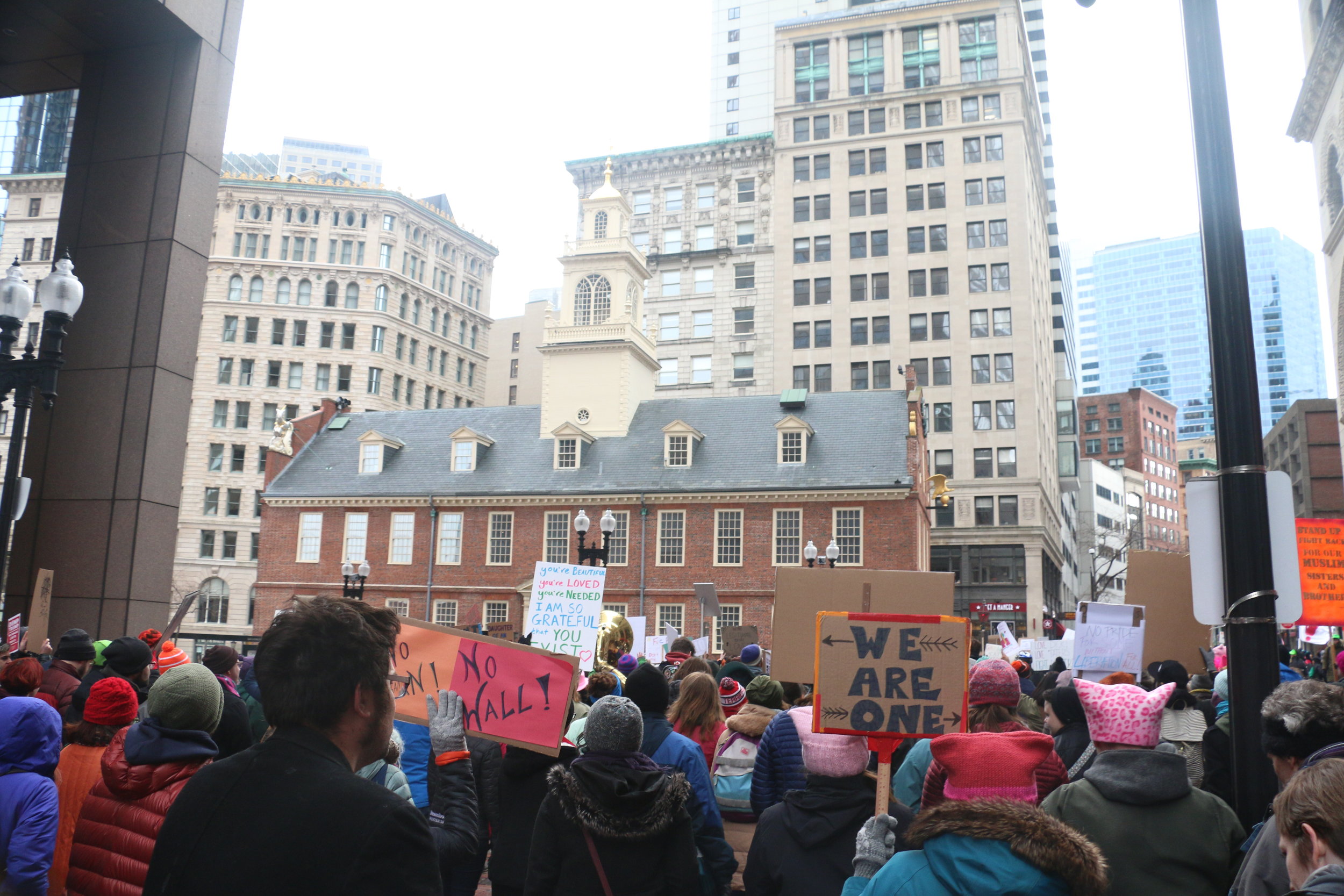On the afternoon of February 5, 2017, the LGBTQ+, Trans, and immigrant population, along with their allies, gathered over 800 people to march in downtown Boston and protest against the Trump administration.
The “Trans and Queer Liberation + Immigrant Solidarity Protest” started at the Boston City Hall and marched on for 1.4 miles to the Trinity Church, where they gathered for a short rally before entering the Community Church of Boston for speeches by community groups. “We’re here, we’re Queer. We’re fabulous” the crowds chanted as they marched past the historic Faneuil Hall.
“This was thrown together pretty ya know, last minute as needed. We’ve been at this for like five days, maybe a week... We just threw it all together and made it happen”, said Diva T. Williams, one of the organizers of the protest.
Williams and her team took advantage of their resources and networks from past social activist events to make this protest happen on such short notice. Jamila Bradley, another organizer, arranged for translators to be available on site, in the crowds, to ensure there were interpreters for the deaf.
Originally the march was going to be in response to the rumored LGBT orders the new Trump administration was going to enact, but since it was not put into action, the march became a platform to demonstrate and allow marginalized populations to get engaged in the community. The march’s goal was to make all populations feel included.
During the Women’s March the phenomenon of ‘pink pussy hats’ was well intended, Bradley explains, but the idea failed to realize the exclusion that went along with it. Bradley says, “Not everyone has a pink pussy – women of color don’t and then trans-women don’t and you’re kind of excluding and creating narratives that maybe require more nuance to your politics.” Bradley wanted to ensure that this march’s aim to make all communities feel welcome was carried out.
Bradley says, “Not everyone has a pink pussy – women of color don’t and then trans-women don’t and you’re kind of excluding and creating narratives that maybe require more nuance to your politics.”
Bradley wanted to ensure that this march’s aim to make all communities feel welcome was carried out.
The march kicked off with a series of speeches from the organizers and people from the community. Among the speakers were two indigenous women who stated that not everyone is an immigrant in this country – that they have been here fighting back since 1492 and will continue to fight. The indigenous women spoke as allies of the immigrant population and wanted to let them know they are here for all. Their heart-filled speech ended with the crowd echoing and chanting their final words: “No ban on stolen land!”
After a few more speeches and musical performances, the crowd erupted into the chant, “Whose streets? Our streets!” and started on their way through the historical streets of downtown Boston. Chants included, “Hey Trump, you’re an a**! Here comes the working class!”, “When black lives are under attack? ‘Stand up, fight back!”. The crowd was in high spirits while yelling along to the chants that people would start.
Despite the passionate tone, the march was peaceful.
“Why wouldn’t it be? Do you see me with a gun?” Williams exclaimed.
While there were some offensive signs directed at Trump, there was no physical harm reported. A protester named Brooke Feinberg explained that the location prevented confrontation with opposing groups.
"We’re lucky that we can do this (march) here. In other places it’s an anomaly and those people who stand up are the real courageous people" Feinberg explained.
While Boston is often perceived as traditionally open minded, liberal city, the organizers still think it is important to fight for people’s rights.
“Lead by example. Be courageous so that other people can follow suit and see how it’s done,” said Mally Smith, another protester.
Rachel Miller, who in the past protested against the Iraqi war, said she was marching this time because she feels
“Intersectionality Matters. We can’t just fight one front.”
Miller said choked up with tears in her eyes.
“I don’t really feel like we’re marching for our neighbors. I feel like we’re marching to let the world know what we have to say,” Miller continued.
She believed that the images of the large crowds saying that we welcome refugees is something that makes it clear that we (Americans) care.
The march gathered onto Copley Square in front of Trinity Church. The crowd was sprinkled in a sea of homemade posters and flags flying high. The organizers said a few more closing remarks before welcoming the crowd into the Community Church of Boston. While inside, attendees were able to network and find possible organizations related to these issues they would possibly want to get involved with in the community.
According to the Facebook event, 1,500 people made it out to the Boston protest. While this sounds slim compared to the supposed 52,000 that went to the Women’s March in January held in Boston, it still accomplished the organizer’s goal to make all populations feel welcome in the community. Williams said,
“You look at anywhere in history of any social movements, it’s always the young people who make it happen”.




